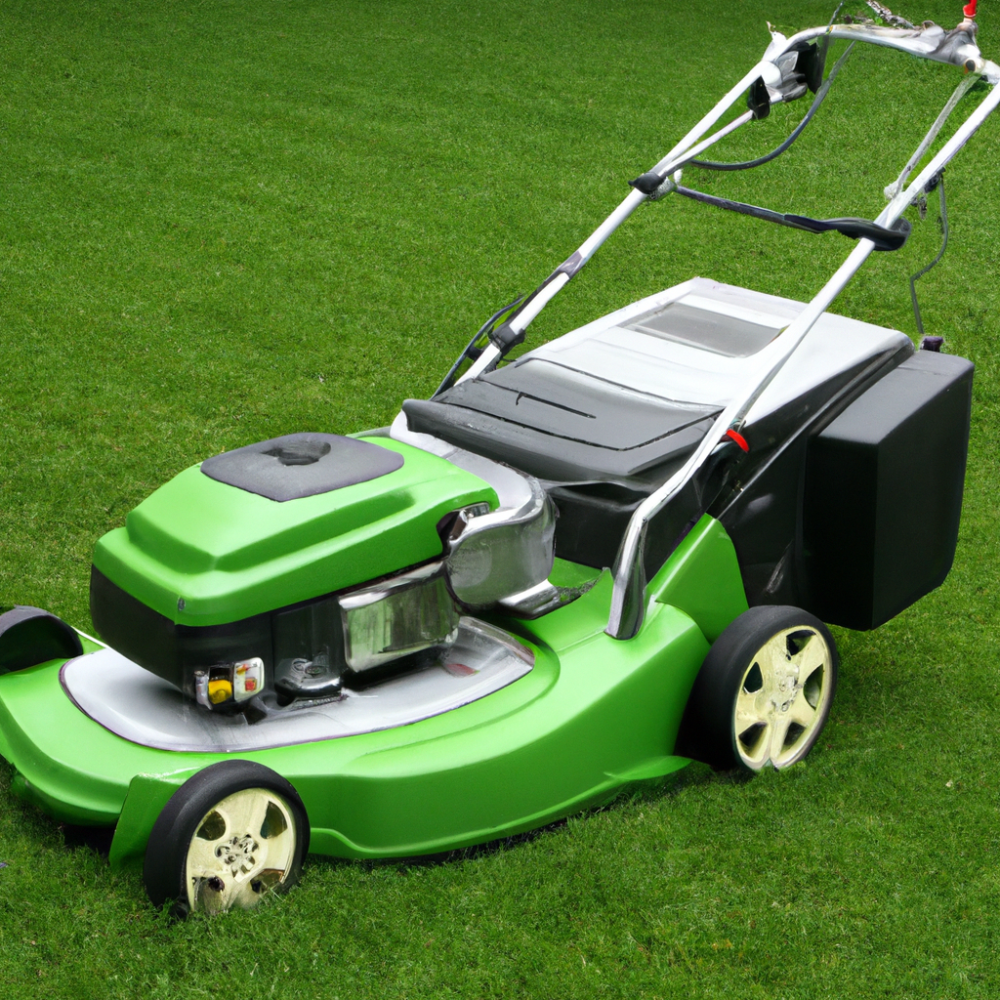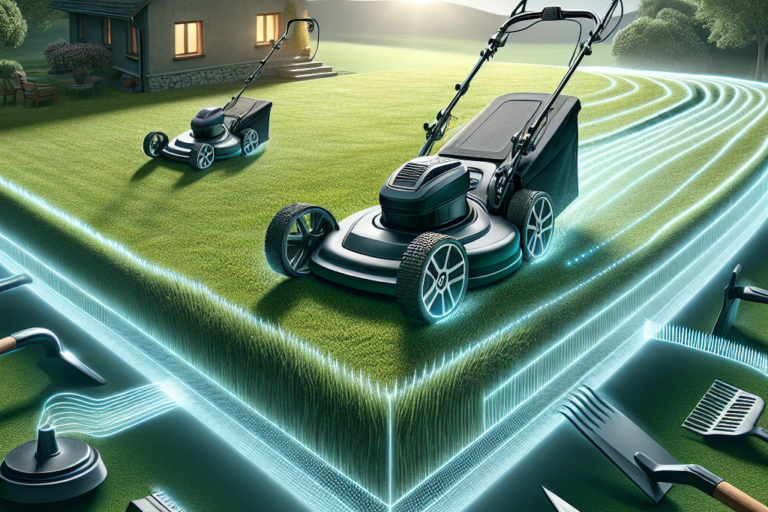Maintaining your electric lawn mower is crucial for its performance and longevity. From regular blade sharpening to cleaning the undercarriage, this article will provide you with essential tips and guidelines to keep your electric lawn mower in top condition. Whether you’re a seasoned gardener or a first-time user, understanding the necessary maintenance tasks will ensure a beautifully manicured lawn all year round. So, let’s dive into the world of electric lawn mower maintenance and discover the simple steps to keep your machine running smoothly. Maintenance plays a crucial role in ensuring the longevity and efficient operation of your electric lawn mower. By regularly cleaning, inspecting, and maintaining various parts of your mower, you can keep it running smoothly and achieve a well-groomed lawn consistently. In this comprehensive article, we will guide you through the essential maintenance tasks for your electric lawn mower, from cleaning the mower to storing it properly.

Cleaning the mower
Keeping your mower clean is essential for its optimal performance. A buildup of debris and grass clippings can impede the mower’s efficiency and potentially damage its components. Let’s walk through the steps of cleaning your electric lawn mower.
Removing debris from the mower
Before cleaning the mower, it’s important to remove any debris that may have accumulated on its surface. Use a brush or a soft rag to gently sweep away dirt, grass clippings, and other particles. Pay special attention to the air vents and the underside of the mower deck, as these areas tend to collect the most debris.
Cleaning the mower blade
The mower blade is the workhorse of your lawn mower, so it’s crucial to keep it clean and in good condition. To clean the blade, first, make sure the mower is turned off and the spark plug is disconnected. Then, use a brush or a cloth to remove any grass clippings or debris stuck to the blade. Be cautious while cleaning and avoid any contact with the sharp edges of the blade.
Washing the mower deck
The mower deck is another area that requires regular cleaning. Using a garden hose or a pressure washer, gently spray water on the underside of the deck to remove any grass clippings or dirt. Be careful not to spray water directly into any electrical components. Once the deck is clean, thoroughly dry it to prevent water damage.
Checking and replacing the battery
The battery is an essential component of an electric lawn mower, and its proper functioning is crucial for consistent performance. Regularly inspecting and maintaining the battery will help extend its lifespan. Let’s explore the necessary tasks for checking and replacing the battery.
Inspecting the battery terminals
Begin by inspecting the battery terminals for any signs of corrosion or damage. Corrosion can hinder the battery’s performance, so it’s important to keep the terminals clean and free of any buildup. If you notice any corrosion, it can be gently removed using a mixture of baking soda and water and a wire brush.
Cleaning the battery terminals
After removing any corrosion, clean the battery terminals with a damp cloth or a battery terminal cleaner. Make sure the terminals are completely dry before moving on to the next step.
Testing the battery
To ensure the battery is functioning optimally, it’s important to test its voltage. Use a voltmeter or a multimeter to measure the battery’s voltage. Compare the reading to the manufacturer’s recommended voltage range. If the voltage is significantly lower than the recommended range, it may be time to replace the battery.
Replacing the battery if necessary
If the battery fails the voltage test or is unable to hold a charge, it’s time to replace it. Consult your electric lawn mower’s manual or contact the manufacturer for the appropriate replacement battery. Follow the manufacturer’s instructions to safely remove the old battery and install the new one.
Inspecting and sharpening the blades
The cutting blades of your electric lawn mower play a vital role in achieving a clean and precise cut. Regular inspection and sharpening of the blades will ensure optimal performance and prevent damage to your mower. Let’s delve into the steps of inspecting and sharpening the blades.
Examining the cutting blades
Start by examining the cutting blades for any signs of wear, nicks, or dents. Damaged blades can result in an uneven cut or even damage the mower. If you notice any significant damage, it may be necessary to replace the blades. Additionally, check for proper tightness and alignment of the blades.
Sharpening the blades
If the blades are dull but free from significant damage, they can be sharpened to restore their cutting efficiency. Remove the blades from the mower following the manufacturer’s instructions and use a sharpening tool, such as a file or a grinder, to sharpen the cutting edges. Ensure that you maintain the original angle of the blades while sharpening.
Balancing the blades
Imbalanced blades can cause excessive vibration and potentially damage the mower. To balance the blades, place them on a blade balancer or a sturdy rod and observe if they tilt to one side. If necessary, remove a small amount of metal from the heavier side until the blades are perfectly balanced.
Inspecting the wheels
The wheels of your electric lawn mower contribute to its maneuverability and overall performance. Regular inspection and maintenance of the wheels will ensure a smooth mowing experience. Let’s explore the necessary steps for inspecting the wheels.
Checking the tires for wear and tear
Inspect the tires of your electric mower for any signs of wear, cracks, or punctures. Worn-out or damaged tires may hinder the mower’s ability to grip the ground and result in an uneven cut. If you notice significant damage to the tires, it may be necessary to replace them.
Inflating the tires if needed
Proper tire inflation is essential for smooth operation and maneuverability. Use a tire pressure gauge to check the tire pressure and compare it to the recommended pressure specified in your mower’s manual. If the tires are underinflated, use a pump to inflate them to the recommended pressure.
Inspecting and lubricating the wheel bearings
Inspect the wheel bearings for any signs of damage or lack of lubrication. Damaged or dry wheel bearings can cause the wheels to seize or wobble, affecting the mower’s performance. If necessary, lubricate the wheel bearings following the manufacturer’s instructions to ensure smooth rotation.

Cleaning and maintaining the air filter
The air filter plays a crucial role in preventing dirt and debris from entering the engine, ensuring its smooth operation. Regular cleaning and maintenance of the air filter will help maintain the mower’s performance. Let’s go through the steps of cleaning and replacing the air filter.
Locating and accessing the air filter
Refer to your electric lawn mower’s manual to locate the air filter. It is generally located near the engine and enclosed in a plastic or metal housing. Follow the manufacturer’s instructions to access the air filter.
Removing and cleaning the air filter
Once you have accessed the air filter, gently remove it from its housing. Inspect the air filter for any signs of dirt or debris accumulation. If the air filter is washable, clean it using mild detergent and warm water. Rinse it thoroughly and allow it to dry completely before reinstalling.
Replacing the air filter if necessary
If the air filter is not washable or is significantly damaged, it may be necessary to replace it. Refer to your mower’s manual or contact the manufacturer for the appropriate replacement air filter. Install the new filter following the manufacturer’s instructions.
Inspecting and replacing the spark plug
The spark plug is responsible for igniting the air-fuel mixture in the engine, and a well-functioning spark plug is essential for efficient operation. Regular inspection and maintenance of the spark plug will ensure optimal performance. Let’s explore the necessary steps for inspecting and replacing the spark plug.
Identifying the spark plug location
Refer to your electric lawn mower’s manual to identify the location of the spark plug. It is typically located on the side or top of the engine. Familiarize yourself with the necessary tools required for spark plug removal, such as a spark plug socket and a wrench.
Removing and examining the spark plug
Once you have located the spark plug, disconnect the spark plug wire. Use a spark plug socket and a wrench to carefully loosen and remove the spark plug. Examine the spark plug for any signs of fouling, such as carbon buildup or damage to the electrode.
Cleaning or replacing the spark plug as needed
If the spark plug is dirty or damaged, it may need to be cleaned or replaced. Use a wire brush or a spark plug cleaner to remove any built-up carbon deposits. If cleaning doesn’t restore the spark plug’s performance, it’s recommended to replace it with a new spark plug that matches your mower’s specifications. Install the new spark plug following the manufacturer’s instructions.

Checking and adjusting the cutting height
The cutting height of your electric lawn mower determines the length of the grass after mowing. Regularly checking and adjusting the cutting height will help achieve the desired lawn appearance. Let’s walk through the necessary steps for checking and adjusting the cutting height.
Examining the cutting height adjustment mechanism
Refer to your electric lawn mower’s manual to familiarize yourself with the cutting height adjustment mechanism. It can typically be found near the wheels or underneath the mower deck. Understand the specific method used to adjust the cutting height, whether it involves presets, levers, or knobs.
Testing the current cutting height
Before adjusting the cutting height, it’s important to determine the mower’s current cutting height setting. Measure the length of the grass that remains after mowing by using a ruler or a tape measure. Compare this measurement to your desired grass height.
Adjusting the cutting height if desired
If the current cutting height does not align with your desired grass length, adjust the cutting height using the adjustment mechanism. Follow the instructions in your mower’s manual to raise or lower the deck to achieve the desired cutting height. Ensure that the deck is adjusted evenly on all sides to ensure an even cut.
Inspecting and lubricating the moving parts
The moving parts of your electric lawn mower require regular inspection and lubrication to ensure smooth operation and extend their lifespan. Let’s delve into the necessary steps for inspecting and lubricating the moving parts.
Identifying the moving parts to inspect
Refer to your electric lawn mower’s manual to identify the moving parts that require inspection and lubrication. This can include the wheel bearings, drive system, and other movable components. Ensure that the mower is turned off and the spark plug is disconnected before proceeding.
Cleaning and lubricating the moving parts as needed
For each moving part, inspect it for any signs of wear, damage, or lack of lubrication. Use a soft cloth or a brush to remove any dirt or debris. Apply an appropriate lubricant recommended by the manufacturer to ensure smooth movement of the parts. Be cautious not to over-lubricate, as excess lubrication can attract dirt and lead to clogging.
Preventing rust and corrosion
In addition to lubrication, it’s important to prevent rust and corrosion on the moving parts. Apply a thin coat of rust-resistant lubricant or a silicone-based spray to protect the parts from moisture and the elements. Regularly inspect the parts for any signs of rust or corrosion and address them promptly.
Verifying the safety features
The safety features of your electric lawn mower ensure your protection and the safe operation of the machine. Regularly testing and inspecting the safety features will provide peace of mind during mowing sessions. Let’s explore the necessary steps for verifying the safety features.
Testing the safety switches
Your electric lawn mower may have safety switches, such as the blade control switch or the operator presence control switch. Test these switches to ensure they are functioning properly. Start the mower and engage the blade control switch while maintaining proper hold on the handle. The blade should only operate when the switch is engaged and the handle is held.
Inspecting the blade control system
Inspect the blade control system, including the cables and the mechanisms that engage and disengage the blades. Ensure that the cables are not worn, frayed, or damaged. If you notice any signs of damage, it’s important to have the blade control system repaired before further use.
Ensuring proper operation of the emergency stop
The emergency stop feature is a critical safety mechanism. Test the emergency stop by pressing the button or pulling the lever to instantly stop the mower. Ensure that the emergency stop feature is easily accessible and effectively stops the mower when activated.
Storing the electric lawn mower
Proper storage of your electric lawn mower during periods of non-use is essential to maintain its condition and performance. Let’s go through the necessary steps for storing your electric lawn mower.
Preparing the mower for storage
Before storing the mower, remove any grass clippings, debris, or moisture. Thoroughly clean the mower following the cleaning steps mentioned earlier in this article. Inspect the mower for any signs of damage or necessary repairs. If you identify any issues, address them before storing.
Cleaning and drying the mower
Ensure that the mower is completely dry before storing to prevent rust or corrosion. Dry the mower using a soft cloth or allow it to air dry. Pay special attention to the mower deck, wheels, and any other areas prone to moisture accumulation.
Storing in a dry and secure location
Store your electric lawn mower in a dry and secure location, such as a shed or a garage, to protect it from the elements. Choose a location that is not susceptible to extreme temperature fluctuations. If possible, cover the mower with a protective cover to further shield it from dust and debris.
By following these comprehensive maintenance procedures for your electric lawn mower, you can ensure its longevity, efficiency, and the quality of your lawn. Regular cleaning, inspection, and maintenance will keep your mower in top shape and ready for the next mowing season. Remember to always consult your electric lawn mower’s manual for specific instructions and recommendations from the manufacturer. Happy mowing!



